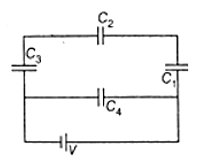Q.
The figure given below shows a network of four capacitors of capacitance equal to $C_{1}=C, \, C_{2}=2C, \, C_{3}=3C, \, C_{4}=4C$ are connected to a battery. If the ratio of charges on $C_{2} \, and \, C_{4}$ is $\frac{p}{q}$ then what is the value of $\left(p + q\right)$ , where $p$ and $q$ are smallest positive integers.

NTA AbhyasNTA Abhyas 2020Electrostatic Potential and Capacitance
Solution: